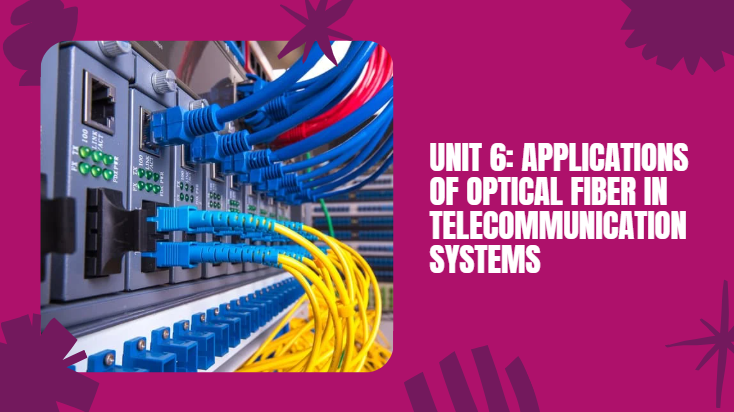PHYSICS S6 UNIT 6: APPLICATIONS OF OPTICAL FIBER IN TELECOMMUNICATION SYSTEMS.

About Course
Optical fibers have revolutionized telecommunication systems, becoming the backbone of global communication networks. They offer significant advantages over traditional copper cables, primarily due to their ability to transmit information as light pulses.
Here’s a detailed look at their applications and the reasons for their widespread adoption:
How Optical Fibers Work in Telecommunications
At its core, optical fiber communication involves:
-
Converting Electrical Signals to Light: At the transmitting end, electrical signals (representing voice, video, or data) are converted into pulses of light, typically using lasers or LEDs.
-
Transmitting Light through Fiber: These light pulses travel along thin strands of glass or plastic (optical fibers) through a process called total internal reflection. The core of the fiber guides the light, while the surrounding cladding reflects it back in, preventing signal loss.
-
Receiving and Converting Back: At the receiving end, a light detector (like a photodiode) converts the optical pulses back into electrical signals, which are then amplified and decoded.
Key Applications of Optical Fiber in Telecommunication Systems.
Optical fibers are extensively used across various telecommunication domains:
-
High-Speed Internet (Broadband): Fiber optic cables are the primary medium for delivering high-speed internet connections to homes and businesses (Fiber to the Home – FTTH, Fiber to the Building – FTTB). They enable faster downloads, smoother streaming of 4K content, and lag-free online gaming.
-
Telephone Networks: They form the core infrastructure for transmitting telephone signals, both locally and across long distances, including intercity and transoceanic communication lines.
-
Cable Television (CATV): Cable companies utilize fiber optics to deliver high-definition television (HDTV), internet, and video services, offering greater bandwidth and signal quality.
-
Data Centers: Within data centers, fiber optic cables are crucial for handling the massive amounts of data transfer between servers and storage systems, ensuring high-speed and efficient operation.
-
Computer Networking (LANs and WANs): They are widely used to connect servers and users in various network settings, including local area networks (LANs) and wide area networks (WANs), improving speed, quality, and accuracy of data transmission.
-
Mobile Network Backhaul (5G): The rollout of 5G networks heavily relies on fiber optic cables to connect cell towers to data centers, providing the necessary high bandwidth and low latency for fast and reliable mobile data.
-
Submarine Communication Cables: Vast networks of fiber optic cables laid across oceans form the backbone of global internet and telecommunication, connecting continents and enabling international communication.
Advantages of Optical Fiber in Telecommunications.
The widespread adoption of optical fiber in telecommunications is driven by several key advantages:
-
High Bandwidth: Optical fibers can carry a massive amount of data simultaneously, far exceeding copper cables. This is due to the high frequency of light waves, allowing for a much wider range of frequencies (bandwidth) to be used.
-
Faster Speeds: Data travels through fiber optic cables at speeds approaching the speed of light, enabling extremely fast data transmission.
-
Longer Transmission Distances: Signals experience significantly less attenuation (signal loss) over long distances compared to copper cables. This reduces the need for frequent signal boosters or repeaters, making long-haul communication more efficient.
-
Immunity to Electromagnetic Interference (EMI): Unlike copper cables that transmit electrical signals, optical fibers transmit light and are therefore immune to electromagnetic interference, radio frequency interference, and crosstalk. This ensures a more reliable and stable connection, especially in environments with high electrical noise.
-
Enhanced Security: Data transmitted through optical fibers is more secure as it’s very difficult to tap into a fiber optic cable without being detected. The light signals are confined within the fiber, making interception challenging.
-
Lightweight and Smaller Size: Fiber optic cables are considerably thinner and lighter than copper cables with comparable capacity, making them easier to install, transport, and requiring less physical space.
-
Durability and Longevity: Optical fibers are highly durable, resistant to harsh environmental factors like temperature changes, moisture, and corrosive substances, leading to a longer lifespan.
-
Lower Total Cost of Ownership: While initial installation costs might be higher in some cases, the long lifespan, lower maintenance requirements, and superior performance often result in a lower total cost of ownership compared to copper systems.
-
Low Latency: Fiber optic networks eliminate many latency issues, leading to better real-time communication, improved voice quality for VoIP, and smoother cloud application usage.
In essence, optical fibers provide the speed, capacity, reliability, and security necessary for the demanding requirements of modern telecommunication systems, making them an indispensable technology for our increasingly connected world.
Course Content
Principles of Operations of Optical Fibers.
-
Definition.
07:26 -
Refractive index of light.
35:46 -
Total Internal Reflection.
00:00 -
Checking my progress.
34:11 -
Questions and Answers
47:13
Types of Optical Fibers.
Mechanism of attenuation.
OPTICAL TRANSMITTER AND OPTICAL RECEIVER.
USES OF OPTICAL FIBERS.
ADVANTAGES AND DISADVANTAGES OF OPTICAL FIBERS.
Assessment
Final Unit Exam.
Student Ratings & Reviews

